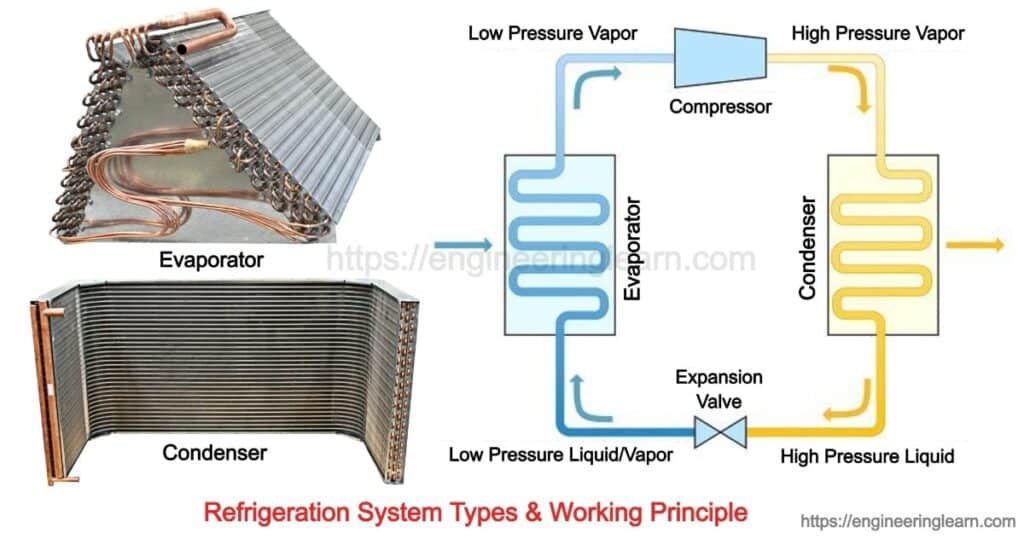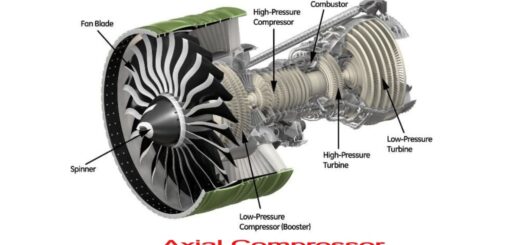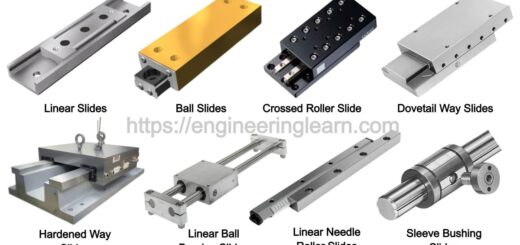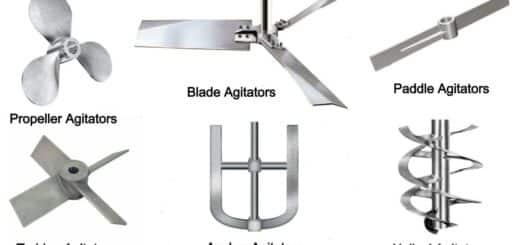Refrigeration System Types and Working Principle [Complete Details]

Introduction of Refrigeration System
Refrigeration System Types and Working Principle :- Refrigeration is referred to as a process in order to achieve and maintain a temperature below that of outer atmosphere with an aim to cool some product or space to the required temperature.
One of the most important application for which refrigeration system is used, is the preservation of the perishable food products by storing them at a comparative lower temperature.
Refrigeration systems are most commonly used for providing the thermal comfort to the human beings so that the air conditioning can be utilized. Here, air Conditioning can be referred to as the treatment of the air in order to simultaneously control the temperature, moisture content, cleanliness, odor and circulation which is required by the occupants.
Types of Refrigeration System
1. Mechanical Compression Refrigeration System: ( Types of Refrigeration System )
The mechanical compression refrigeration system is referred to as those system which is most widely-used in the refrigeration cycle method due to its multiple applications like air conditioning, commercial and industrial refrigeration etc. Most commonly these are the systems which are likely to transfer the heat by mechanically compressing the refrigerants into a quite low-pressure, cold liquid and by expanding it into hot or high-pressure gas. Once the heat is absorbed and released it the cool are is emitted and the hot air is condensed back into liquid.
2. Evaporative Cooling System: ( Types of Refrigeration System )
Evaporative cooling is quite different from the mechanical compression as it is traditional refrigeration cycle which has been followed from years. This was the technique which can cool the warmer outdoor air as well by the help of water-soaked pads by blowing it over your home or the required area. The water soaked pads work in the way that the water absorbs the heat from the air and evaporates once the cooler air is floated into the area after which the warm air is directed out of it.
3. Absorption Refrigeration System: ( Types of Refrigeration System )
Absorption refrigeration is referred to as a system in which the heat is also transferred by the process of compression and expansion refrigerant which is found to be quite similar to the mechanical compression. This is the kind of refrigeration system which relies on the process of absorption and heats in order to move the refrigerant which varies from the lower pressure side to the higher pressure side, rather of an electrically-powered mechanical compressor.
4. Thermoelectric Refrigeration System: ( Types of Refrigeration System )
Thermoelectric refrigeration systems is referred to as the most unique which because they do not use any water or refrigerant rather they use a thermoelectric refrigeration system wherein the thermocouple and the electric current does its job. The thermocouple is constructed of two different metal wires which is united at both the ends whereas the rest of the wires are separated by the insulation.
Thermoelectric refrigeration system is the system which works by using the Peltier effect in order to create a heat flux within the junctions of two different types of materials. This type of refrigeration system is most commonly used in camping, at places where portable coolers are needed and for also cooling the electronic components and small instruments.
Working of Thermoelectric Refrigeration System
By applying the DC voltage difference within the thermoelectric module, an electric current is found to pass through the module wherein the heat is absorbed from one side and is then released from the opposite side. Therefore, one module face is found to be cooled whereas the opposite face is heated simultaneously.
As soon as the current is directed to the thermocouple, its one end is found to become hot whereas the other end becomes cooler. Practically, the hot end is mostly placed outside the area which is to be cooled while the heat sink is attached to it in order to keep the same temperature as that of the surrounding air. Whereas the cooler side is placed in the area to be cooled which attracts heat from the air in order to make it perfect for small cooling loads which can be difficult to access like the electronic systems.
5. Artificial Refrigeration: ( Types of Refrigeration System )
Artificial refrigeration is named so as it is produced by the artificial means. Although it is quite tedious to make a clear demarcation between the natural and the artificial refrigeration but it is generally accepted that the history of an artificial refrigeration was started in the year 1755. This was the working principle on which the refrigeration system was further classified as vapour compression systems, vapour absorption systems, gas cycle systems, etc.
6. Vapour Compression Refrigeration System: ( Types of Refrigeration System )
Vapour compression refrigeration system works on a cycle which is an improved type of air refrigeration cycle found suitable for working substance which is termed as refrigerant. The commonly used refrigerants for this purpose are ammonia (NH3), carbon dioxide (CO2) and sulphur-dioxide (SO2).
The refrigerant which is used is found not leaving the system, whereas is circulated throughout the system alternately condensing and evaporating. In the condensing process, it is found giving out the latent heat to the circulating water of the cooler. The vapour compression cycle which is also used in the vapour compression refrigeration system is nowadays widely used for all-purpose refrigeration. Most commonly it is used for all industrial purposes from a small domestic refrigerator to a big air conditioning plant.
7. Vapour Absorption Refrigeration System: ( Types of Refrigeration System )
The vapour absorption refrigeration system is referred to as a system which is heat-operated and is quite similar to the vapour compression system. The best part about both the refrigeration systems is that there are evaporators and condensers present in them. It should be noted that the process of evaporation and condensation of the refrigerant takes place at two different pressure levels in order to achieve refrigeration in both the cases. The method which is employed to create the two pressure levels in the system for evaporation and condensation of the refrigeration which makes the two processes different as well as possible simultaneously. Along with this the process of circulation of refrigerant is also found to be different in both the cases.
The process of absorption in the compressor of the vapour compression system is exchanged by the combination of absorber and generator. The solution which makes it possible is referred to as the absorbent, which has an ability for the refrigerant used and is circulated within the absorber and the generator through a solution pump. Here, the absorbent is referred to as the absorber draws from where the refrigerant vapours are formed in the evaporator which are mostly important for maintaining a lower pressure in the evaporator in order to enable the refrigerant to evaporate at a comparatively lower temperature.
Working of Vapour Absorption Refrigeration System
In the generator the absorbent is heated which is responsible for releasing the refrigerant vapour in the form of high-pressure vapour which thereafter needs to be condensed by the help of the condenser. Also the suction function is can be performed by the absorbent in the absorber where the generator is found performing the function of the compression and discharge. The absorbent solution is found carrying the refrigerant vapour from the lower side to the high side. The refrigerant which is found in the liquefied form, flows from the condenser to the evaporator because of to the pressure difference which is caused within the two vessels, therefore establishing the circulation of the refrigerant through the system.
8. Solar Energy Based Refrigeration Systems: ( Types of Refrigeration System )
There are various attempts being made to run the vapour absorption systems by the usage of solar energy by concentrating and flat plate solar collectors. Simultaneously there were several small solar absorption refrigeration systems which was made in the year 1950 in various countries. A solar refrigeration system is found to produce around 250 kg of ice per day which was first installed in Tashkent, USSR in the year 1953. This was the system which is used as a parabolic mirror of 10 m2 area in order to concentrate the effect of solar radiation. There was an absorption machine with a cylinder-parabolic mirror of 20 m2 at Montlouis, France, which was found producing around 100 kg of ice each day.
9. Gas Cycle Refrigeration System: ( Types of Refrigeration System )
As the vapours are used for the cooling purpose in the vapour compression cycle and vapour absorption cycle, the gas is similarly used for the purpose of cooling in the gas refrigeration cycle. Once the gas is throttled from comparatively higher pressure to lower pressure in the throttling valve, its temperature is found to reduce suddenly whereas its enthalpy remains consistent. This is the main principle which is used in a gas refrigeration system.
In this type of refrigeration system rather than using freon or ammonia as the refrigerant, the gas is used as the refrigerant. Throughout the complete cycle there is no phase change observed in the gas, which are found to be in the liquefied form. The most popular gas which is used as a gas is air and is also terms as refrigerant in the case of gas refrigeration cycles.
10. Steam Jet Refrigeration System: ( Types of Refrigeration System )
The steam jet refrigeration works on the principle of boiling the water under 100 degree centigrade. If the pressure on the surface of the water is found to be reduced below atmospheric pressure then the water can be made to boil at the lower temperatures as well.
11. Vortex Tube Refrigeration System: ( Types of Refrigeration System )
Vortex tube system is referred to as a non-conventional type of refrigerating systems which is used for the purpose of refrigeration.
The vortex tube is actually referred to as a mechanical device which is used for separating a high-pressure flow which enters tangentially into two low-pressure flows, in order to generate a temperature difference. This mechanical device is found having no moving part and usually consists of a circular tube with nozzles and throttle valve. High-pressure gasses enters in through the vortex tube tangentially through the nozzles which increases the angular velocity and therefore is responsible for the production of a swirl effect.
The vortex tube is found having two. The hot exit is located in the outer radius near the far end of the nozzle whereas the cold exit is located in the Centre of the tube near the nozzle. The gas gets separated into two different layers. The gas which is found to be closer to the axis has a lower temperature that comes out through the hot exit.
Working Principle of Refrigeration System
Refrigerators are found to work on the three basic principles which take heat from one place and move it to another. The refrigerator consists of numerous metal pipes which is referred to as the evaporator coils. The liquid refrigerant which is present is found to circulate through the coil, to change it into a gas which draws heat out of the refrigerator after which the refrigerant gas passes through a device which is known as a compressor and is found to raise its pressure and temperature.
After this it flows into the condenser via condenser coils which is located outside the refrigerator, and then it returns into the liquefied form and releases the heat which is absorbed while passing the evaporator coils. The heat which is released is distributed to the air outside the refrigerator. After this the liquefied refrigerant passes through the expansion valve, where its pressure gets dropped before it returns to the evaporator coils in order to absorb more heat and turn back into a gas. This is how the cycle is repeated over and over till the system is functional.
The Science Behind Refrigeration
The science behind the refrigeration system has not changed from the first ice machines were built in the early 1800s. Here are some of the basic principles due to which the refrigeration system was possible:
- All the substances are found existing in one of the three states like solid, liquid or gas. Water is found to turn into solid ice at quite lower temperature and becomes liquid when it is heated. It then turns into vapour when the higher temperature is applied. The same is valid for all the similar types of substances which include those that are commonly used in the refrigeration industry.
- Whenever a substance is found to evaporate, it draws heat from the atmosphere. This is the reason similar to that when you boil a pot of water and the steam comes off of it due to its heat.
Image Source :- Superradiatorcoils













